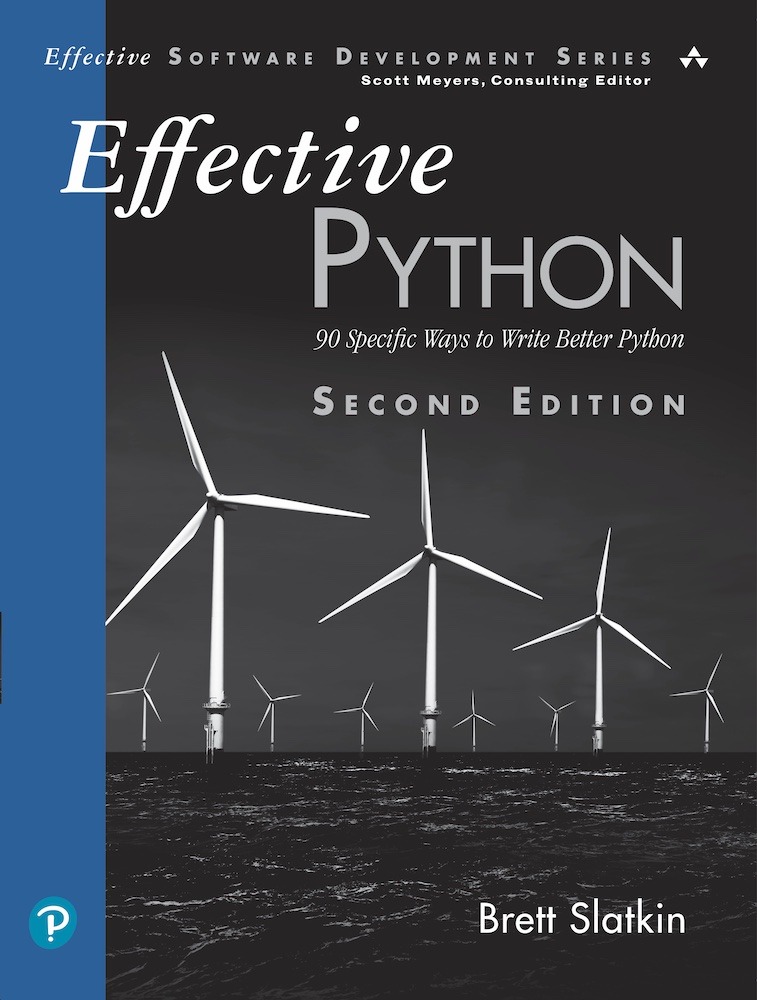What This Book Covers
Each chapter in Effective Python: Second Edition contains a broad but related set of items. Feel free to jump between all 90 items and follow your interest. Each item contains concise and specific guidance explaining how you can write Python programs more effectively. Items include advice on what to do, what to avoid, how to strike the right balance, and why this is the best choice. Items reference each other to make it easier to fill in the gaps as you read.
This second edition is focused exclusively on Python 3, up to and including version 3.8. It contains 30+ completely new items with additional best practices. Most of the original items from the first edition have been revised and included, but many have undergone substantial updates. For some items my advice has completely changed between the two editions of the book due best practices evolving as Python has matured.
If, for whatever reason, you’re still primarily using Python 2, despite its end-of-life on January 1st, 2020, the previous edition of the book (and its translations) may be more useful to you.
Chapter 1: Pythonic Thinking
The Python community has come to use the adjective Pythonic to describe code that follows a particular style. The idioms of Python have emerged over time through experience using the language and working with others. This chapter covers the best way to do the most common things in Python.
- Know Which Version of Python You’re Using
- Follow the PEP 8 Style Guide
- Know the Differences Between
bytes and str
- Prefer Interpolated F-Strings Over C-style Format Strings and
str.format
- Write Helper Functions Instead of Complex Expressions
- Prefer Multiple Assignment Unpacking Over Indexing
- Prefer
enumerate Over range
- Use
zip to Process Iterators in Parallel
- Avoid
else Blocks After for and while Loops
- Prevent Repetition with Assignment Expressions
Chapter 2: Lists and Dictionaries
In Python, the most common way to organize information is in a sequence of values stored in a list. A list‘s natural complement is the dict that stores lookup keys mapped to corresponding values. This chapter covers how to build programs with these versatile building blocks.
- Know How to Slice Sequences
- Avoid Striding and Slicing in a Single Expression
- Prefer Catch-All Unpacking Over Slicing
- Sort by Complex Criteria Using the
key Parameter
- Be Cautious When Relying on
dict Insertion Ordering
- Prefer
get Over in and KeyError to Handle Missing Dictionary Keys
- Prefer
defaultdict Over setdefault to Handle Missing Items in Internal State
- Know How to Construct Key-Dependent Default Values with
__missing__
Chapter 3: Functions
Functions in Python have a variety of extra features that make a programmer’s life easier. Some are similar to capabilities in other programming languages, but many are unique to Python. This chapter covers how to use functions to clarify intention, promote reuse, and reduce bugs.
- Never Unpack More Than Three Variables When Functions Return Multiple Values
- Prefer Raising Exceptions to Returning
None
- Know How Closures Interact with Variable Scope
- Reduce Visual Noise with Variable Positional Arguments
- Provide Optional Behavior with Keyword Arguments
- Use
None and Docstrings to Specify Dynamic Default Arguments
- Enforce Clarity with Keyword-Only and Position-Only Arguments
- Define Function Decorators with
functools.wraps
Chapter 4: Comprehensions and Generators
Python has special syntax for quickly iterating through lists, dictionaries, and sets to generate derivative data structures. It also allows for a stream of iterable values to be incrementally returned by a function. This chapter covers how these features can provide better performance, reduced memory usage, and improved readability.
- Use Comprehensions Instead of
map and filter
- Avoid More Than Two Control Subexpressions in Comprehensions
- Avoid Repeated Work in Comprehensions by Using Assignment Expressions
- Consider Generators Instead of Returning Lists
- Be Defensive When Iterating Over Arguments
- Consider Generator Expressions for Large List Comprehensions
- Compose Multiple Generators with
yield from
- Avoid Injecting Data into Generators with
send
- Avoid Causing State Transitions in Generators with
throw
- Consider
itertools for Working with Iterators and Generators
Chapter 5: Classes and Interfaces
Python is an object-oriented language. Getting things done in Python often requires writing new classes and defining how they interact through their interfaces and hierarchies. This chapter covers how to use classes to express your intended behaviors with objects.
- Compose Classes Instead of Nesting Many Levels of Built-in Types
- Accept Functions Instead of Classes for Simple Interfaces
- Use
@classmethod Polymorphism to Construct Objects Generically
- Initialize Parent Classes with
super
- Consider Composing Functionality with Mix-in Classes
- Prefer Public Attributes Over Private Ones
- Inherit from
collections.abc for Custom Container Types
Chapter 6: Metaclasses and Attributes
Metaclasses and dynamic attributes are powerful Python features. However, they also enable you to implement extremely bizarre and unexpected behaviors. This chapter covers the common idioms for using these mechanisms to ensure that you follow the rule of least surprise.
- Use Plain Attributes Instead of Setter and Getter Methods
- Consider
@property Instead of Refactoring Attributes
- Use Descriptors for Reusable
@property Methods
- Use
__getattr__, __getattribute__, and __setattr__ for Lazy Attributes
- Validate Subclasses with
__init_subclass__
- Register Class Existence with
__init_subclass__
- Annotate Class Attributes with
__set_name__
- Prefer Class Decorators Over Metaclasses for Composable Class Extensions
Chapter 7: Concurrency and Parallelism
Python makes it easy to write concurrent programs that do many different things seemingly at the same time. Python can also be used to do parallel work through system calls, subprocesses, and C extensions. This chapter covers how to best utilize Python in these subtly different situations.
- Use
subprocess to Manage Child Processes
- Use Threads for Blocking I/O, Avoid for Parallelism
- Use
Lock to Prevent Data Races in Threads
- Use
Queue to Coordinate Work Between Threads
- Know How to Recognize When Concurrency Is Necessary
- Avoid Creating New
Thread Instances for On-demand Fan-out
- Understand How Using
Queue for Concurrency Requires Refactoring
- Consider
ThreadPoolExecutor When Threads Are Necessary for Concurrency
- Achieve Highly Concurrent I/O with Coroutines
- Know How to Port Threaded I/O to
asyncio
- Mix Threads and Coroutines to Ease the Transition to
asyncio
- Avoid Blocking the
asyncio Event Loop to Maximize Responsiveness
- Consider
concurrent.futures for True Parallelism
Chapter 8: Robustness and Performance
Python has built-in features and modules that aid in hardening your programs so they are dependable. Python also includes tools to help you achieve higher performance with minimal effort. This chapter covers how to use Python to optimize your programs to maximize their reliability and efficiency in production.
- Take Advantage of Each Block in
try/except/else/finally
- Consider
contextlib and with Statements for Reusable try/finally Behavior
- Use
datetime Instead of time for Local Clocks
- Make
pickle Reliable with copyreg
- Use
decimal When Precision Is Paramount
- Profile Before Optimizing
- Prefer
deque for Producer–Consumer Queues
- Consider Searching Sorted Sequences with
bisect
- Know How to Use
heapq for Priority Queues
- Consider
memoryview and bytearray for Zero-Copy Interactions with bytes
Chapter 9: Testing and Debugging
You should always test your code, regardless of what language it’s written in. However, Python’s dynamic features can increase the risk of runtime errors in unique ways. Luckily, they also make it easier to write tests and diagnose malfunctioning programs. This chapter covers Python’s built-in tools for testing and debugging.
- Use
repr Strings for Debugging Output
- Verify Related Behaviors in
TestCase Subclasses
- Isolate Tests from Each Other with
setUp, tearDown, setUpModule, and tearDownModule
- Use Mocks to Test Code with Complex Dependencies
- Encapsulate Dependencies to Facilitate Mocking and Testing
- Consider Interactive Debugging with
pdb
- Use
tracemalloc to Understand Memory Usage and Leaks
Chapter 10: Collaboration
Collaborating on Python programs requires you to be deliberate about how you write your code. Even if you’re working alone, you’ll want to understand how to use modules written by others. This chapter covers the standard tools and best practices that enable people to work together on Python programs.
- Know Where to Find Community-Built Modules
- Use Virtual Environments for Isolated and Reproducible Dependencies
- Write Docstrings for Every Function, Class, and Module
- Use Packages to Organize Modules and Provide Stable APIs
- Consider Module-Scoped Code to Configure Deployment Environments
- Define a Root
Exception to Insulate Callers from APIs
- Know How to Break Circular Dependencies
- Consider
warnings to Refactor and Migrate Usage
- Consider Static Analysis via
typing to Obviate Bugs

